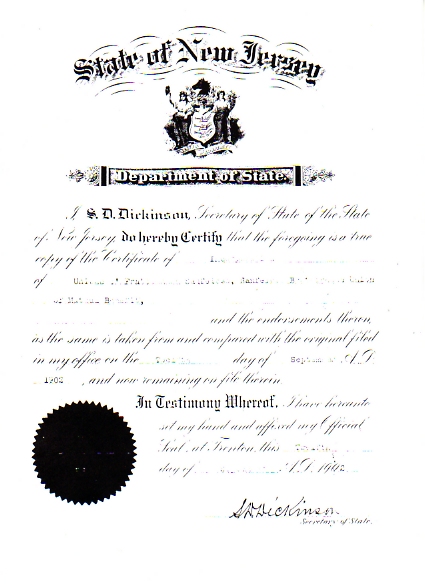
110th ANNIVERSARY
UNIONE E FRATELLANZA SANFELESE
BY: TOM FRASCELLA MARCH 2012
This year marks the 110th anniversary of the founding and incorporation of the Unione e Fratellanza San Felese. The organization’s start date was on April 10, 1902 in Trenton, New Jersey. The organization was established as a “mutual benefit’ society limited to those people who either came from or descended from immigrants from the small southern Italian village of San Fele. It is presently the oldest Italian-American Society in central New Jersey and among the oldest in the State.

Incorporation Certificate
The questions arise, what is a mutual benefit society and what is the purpose? Mutual benefit societies have been around for almost as long as human civilizations have existed. Ancient texts attest to the existence of such organizations in ancient Greece, Rome, China and throughout many other cultures in the world. It would appear that whenever most cultures were faced with serious social problems that were not being adequately addressed by their government, people would band together privately to supply mutual aid, support and manpower to mitigate the impact of the problem they were facing. Mutual benefit societies are self-help organizations. They are structured to either benefit their members directly or some larger social unit through group cooperation.
Most mutual benefit organizations originally formed with some singular social purpose in mind. From this purpose the organization continued in existence until the purpose was satisfied. Most of these types of organizations at that point would dissolve. Some of these organizations however, continued their existence by expanding or altering their charter to address new problems or issues. In the 1800’s in the U.S. and abroad there were hundreds of mutual aid societies which arose at every class level and among every ethnic group. During this time Governments played a far less direct role in the daily lives of people and few if any Government social programs existed. Today Government has greatly expanded its role of providing more of a social safety net for its citizens. However it would be wrong to think that such organizations no longer are important resources in our present societies. For example many aid organizations have been established in recent years to raise money for medical research, supply medicine and medical care to the needy, help victims of natural disasters, preserve historic sites, improve environmental conditions etc. So, mutual aid societies of various types are alive and well in our present times.
As the mass immigration of Italians began in the mid 1800’s they quickly began to form aid and benefit societies. One of the earliest mutual aid societies founded by Italian immigrants to the U.S. was founded in 1866 in Chicago. It was called “Societa di Unione e Fratellanza” and even published its own newspaper “L’Unione Italiana” between 1867 and 1869. This early Italian American organization, proud of its heritage, hosted Chicago’s first Columbus Day Parade in 1868.
In 1902 the San Felese community residing in and around Trenton, New Jersey formerly came together and established their “Botherhood or Fratellanza”. There are some things that I should point out to put the founding of our organization in its proper historical perspective. In 1902 the San Felese community that was present in Trenton primarily resided in a section of Trenton that was known as the “Chambersburg Neighborhood”. Although Trenton had been the State Capitol since the 1790’s it was originally a very small town. As late as 1850 Trenton had a population of less than 8,000 people. In those early years Trenton’s geographic and economic center lay near the intersection of State St. and Broad St. From this center as the town grew it expanded south, east and north with the Delaware River being its westerly boundary. When the San Felese began arriving in Trenton in the early 1860’s there was no Chambersburg section and the steel mills had not expanded yet. The Roebling Mill for example was located solely by the river and employed in the 1860’s fewer than one hundred people. When Vito Frascella arrived in Trenton in 1862 he took rooms on Market St. which today we would consider more center city. Market Street in that period was both a commercial and residential hub.
Until the 1880’s the area known as “Chambersburg” was not within Trenton’s city limits. Chambers Farm as it was then known was a 35 acre tract of land and a part of Hamilton Twp. The American Industrial Revolution took off in the late 1870’s and 1880’s and Trenton was very much a part of that industrial boom. Trenton became home to steel factories, rubber factories, ceramics and garment production to name but a few areas of manufacture. The area that would become Chambersburg saw the building and expansion of several steel plants and the Roebling Company purchased the Chambers’tract at that time. When those factories were built they required expanded labor and the labor required housing. The housing that expanded around the steel plants became known to the east of the plants as east Trenton and in part Chambersburg. Eventually most of east Trenton would be considered Chambersburg but the core area of the “Burg” was the twelve square housing blocks of Bayard, Butler, Elmer and Mott streets.
Initially in the early 1870’s and 1880’s almost all of the factory labor was native born American, rounded out by German and Irish immigrants. But soon southern Italians and eastern Europeans began to arrive and the factory bosses soon identified them as labor pools that would work for less. Southern Italians began to settle in the area known as Chambersburg starting in the 1880’s. At first they were a minority in what was then predominately a German and Irish neighborhood. They were not well received in part because they were undercutting wages and were competition but also because their language, foods and customs were unfamiliar to their new neighbors.
Census data reflects that Italians and Italian Americans did not make up a majority of the Chambersburg neighborhood until about 1910. The “Burg” as it was also known did not become predominately/almost exclusively “Italian” until later still around 1920. What few people realize however is that between 1880 and 1905 the majority, up to 80%, of all “Italians” living in Chambersburg hailed from the Lucania region. Within that number approximately two thirds of the Lucanians were from San Fele. As we have stated our records reflect that the San Felese started settling in Trenton in 1862. Since our Society was started in 1902 one might read this as indicating that it took the San Felese community forty years to form a mutual aid society. That isn’t the case at all. Actually the San Felese in Trenton formed a number of formal mutual aid societies with very specific social purposes of which our present society is only one. In fact it was the last society that they organized but the only one that remains active. Like many organizations that had a specific purpose the earlier San Felese organizations faded as their purpose resolved.
Lucanians in Trenton in those early days were tightly associated by age old connections to that specific region. Italians/Lucanians especially from a twenty or thirty mile radius of their native towns would consider each other “campanilismo”. For those who don’t understand the nature of the isolated highland villages of Lucania it might be helpful to think of them as “clansmen” with centuries of inter village marital/social relationships. The word “campanilismo” is interesting as it has no direct English equivalent. Literally, it means “bell tower” of the type that is free standing and unattached to a church or public building. Bell towers were of course the public announcement/warning devices of their time. By ringing the bells you would alert the community to danger, threats, fire and other major events. The people within hearing distance of the Bell alarm were those who would respond for mutual aid and support. Therefore, they were the ones upon who you depended and trusted with your safety and survival. In the foreign and often dangerous and hostile environment these early Italian immigrants faced in the U.S. the concept of “campanilismo” was a mater sometimes of life or death. The San Felese relationship to each other was one of “paesani” meaning from the same town. Of course, from the rural more isolated regions like San Fele being from the same town “paesani” also meant being related or family and so the association was especially close.
The isolation and closeness of the Lucanian “highland” culture dictated strong bonds of support. In my readings about the Lucania region as it existed in the 1860-1900’s I have noted that despite or maybe because of the systemic poverty and natural disasters each of the towns and villages maintained a special “relief” fund as part of their annual public treasury. The concept of mutual aid was a cultural and institutional reality imported with them as the settled in to their new homeland.
In the early pre-20th century Chambersburg Italian community, the majority of the community was “campanilismo”, from the Potenza region of Lucania. It was natural that they would form mutual aid associations and they did. Some of those associations were informal but some were formed in a very public formal way.
When they went for the cost, effort and public notice of forming a formal organization there was generally a larger social issue that they were dealing with. The San Felese Fratellanza is an example of one of the community’s “formal” organizations. As you can see from the above State Incorporation document they wanted “legal” recognition by the State of New Jersey for the organization. The documents that follow demonstrate that they designed the organization to be recognized as a nonprofit under the State Act of 1898. They also went to the expense of having a book outlining member obligations and bylaws. The book was printed and produced in New York City. So they went through a great deal of trouble to do it right. The details and documentation relating to the formation of the organization suggests that the founders were sophisticated enough to carefully plan and execute their intent. Clearly they knew exactly what they wanted and how to achieve it.
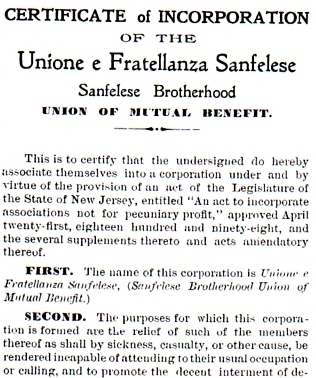
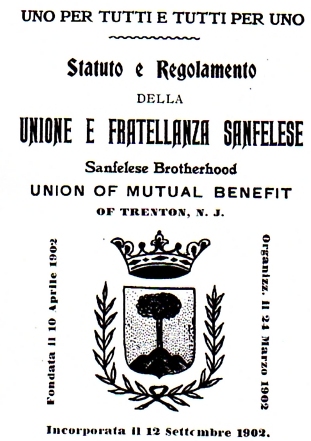
pages of the bylaw book
As you can read the stated purpose of the organization was to provide “the relief of such members thereof as shall by sickness, casualty, or other cause, be rendered incapable of attending to their usual occupation or calling, and to promote the decent interment of the deceased members”. In other words, to provide sick and death benefits to its members.
To be a member of the organization one had to be of San Felese birth or descent. Beyond that a member had to be able to pay annual dues. The organization would have been attractive to those in the community who were concerned about interruption of wages and had a steady enough income to set aside the dues payment as protection.. Generally, newly arrived immigrants were not in a position to have excess money to pay for this type of “work” insurance. The organization was therefore looking to members who were already established in positions with steady income.
If we realize that at the turn of the century most San Felese were employed in the steel factories or in other manual labor tasks it is easy to understand that they had concerns as to their safety and potential exposure to illness. The factories were very dangerous environments for workers and deaths and injuries were common. Foul air and poor ventilation with little or no climate control made airborne type illness a standard threat. Labor organizations and collective bargaining were not only discouraged attempts to organize were actually attacked by the factory bosses. Workers had no rights and continued employment was subject to the decisions of the bosses. Some workers were fired simply as a lesson to others.
The “Fratellanza” was originally formed as a modest buffer against labor based injury and death and abuse. This was not well received by the factory bosses. Society members quickly gained through their association an enhanced voice against management. Not surprisingly the factory bosses often characterized the men and their societies as “labor agitators”. When Roebling New Jersey was established as a “new” company town, down river in 1905 factory management barred all Italian workers from those new plants and prohibited the primarily Eastern European factory workers their from forming fraternal organizations within the company town limits. The fact that the factory owners sought ways to break the societies control over labor shows the extent that the societies. As I mentioned the San Felese formed a number of mutual aid societies during this period aimed at specific social tasks, often related to labor conditions.
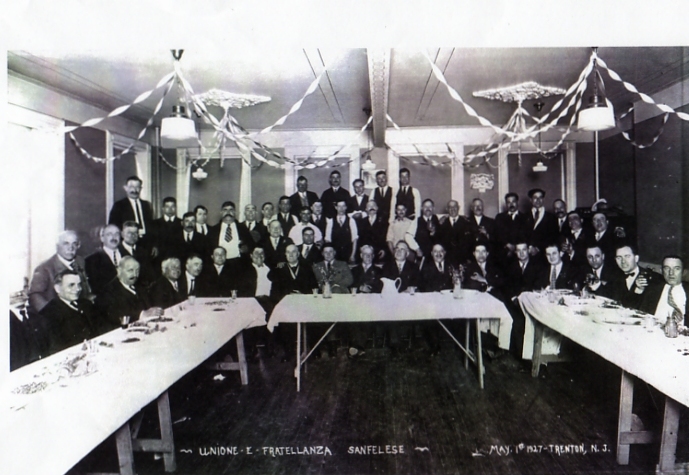
1927 photo of society members 25th Anniversary
The San Felese of the 1880-1910 era in Trenton may have been at the bottom of the employment ladder but that should not be equated with being passive victims of their economic plight. They understood their world and how it worked. The San Felese Society is an example of how they developed strategies to advance the protection of their positions within it. Even when the deck was stacked against them they figured out ways to shuffle the deck.
With regard to the community helping the newly arrived San Felese or those that had fallen on hard times, the community tended to deliver services in an informal way. First through extended family support or sometimes the community would raise money, food, clothing etc. Often San Felese women would take the led in this going from home to home collecting donations. This was not viewed as charity but rather as temporary support. The men of the Society would also get involved in raising funds but again in an informal individual way rather than through the formal offices of the organization. The Society itself as years progressed served as a way of bringing families together and reinforcing their social and familial connections.
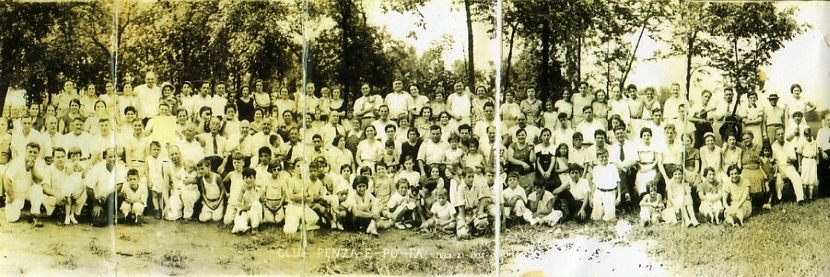
San Felese picnic photograph from 1935
Through the years the society has survived because it has consistently recognized changes occurring in society and the needs of the community. For example, membership was once reserved for the male descendants of males. As more intermarriage became common membership was expanded to male descendants along either male or female lines. Eventually again recognizing changing marriage trends membership now requires only one ancestor somewhere in the line of descent and is open to both male and female members.
Also as the sick and death benefit became less important the organizations focus has shifted to cultural educational and heritage preservation. This website is an example of the way we are altering the process of reaching out to the community. The Italian “Burg” fell victim to changing economic pressures and movement out to the suburbs and beyond. We no longer can reach a community centered within a small geographic area. The internet provides us with an opportunity to reach out to our Fratellanza instantly worldwide.
Although we are celebrating 110 years of history the Society looks forward with continued vigor to our future, the next cent anni.
© San Felese Society of New Jersey